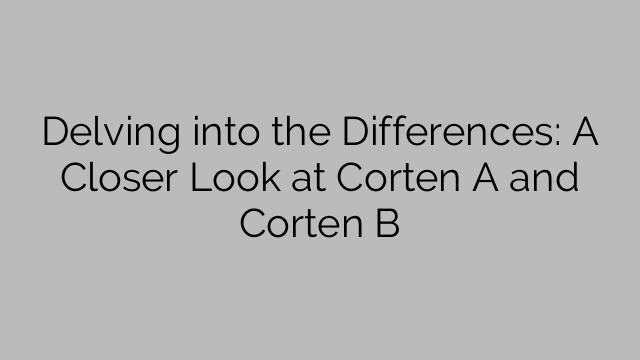構成:
One of the primary differences between Corten A and Corten B lies in their chemical composition. Corten A is primarily comprised of iron, while it also contains small amounts of copper, chromium, nickel, and phosphorous. On the other hand, Corten B also contains iron, but in addition to copper, chromium, nickel, and phosphorous, it also includes vanadium. The inclusion of vanadium helps improve its weather resistance capabilities.
Weathering Properties:
Both Corten A and Corten B are known for their excellent weathering properties. Weathering steel, also known as “Cor-Ten” or “Atmospheric Corrosion Resistant Steel,” forms a protective layer or patina when exposed to the elements. This patina acts as a barrier between the steel and the external environment. It not only slows down the rate of corrosion but also enhances the steel’s resistance to atmospheric pollutants.
Corten A is a weathering steel grade that exhibits higher resistance to atmospheric corrosion when compared to ordinary carbon steel. It can be used in a variety of applications, including bridges, buildings, and outdoor sculptures. Corten B, on the other hand, offers similar weathering properties to Corten A but with added endurance. The inclusion of vanadium in its composition makes it suitable for more demanding and harsh environments.
用途:
Due to their weathering properties and aesthetic appeal, both Corten A and Corten B find extensive usage in architectural and outdoor applications. These include building facades, roofing, cladding, landscaping, and artistic sculptures. The unique rusty appearance of weathering steel adds a touch of character and charm to any structure, making it a popular choice among architects, designers, and artists alike.
Corten A is often recommended for moderate corrosive applications and is ideal for environments where there is a constant exposure to moisture and atmospheric conditions. Corten B, with its increased weather resistance, is suitable for applications subjected to more severe atmospheric conditions, such as coastal areas or industrial environments with higher levels of pollutants.
Availability and Cost:
Both Corten A and Corten B are readily available in various dimensions and thicknesses from reputable steel suppliers. Being high-strength low alloy (HSLA) steels, they may be slightly more expensive than regular carbon steel. However, their enhanced corrosion resistance and longer lifespan offset the initial investment.
In conclusion, while Corten A and Corten B share similar weathering properties and have widespread applications in architecture and outdoor design, the inclusion of vanadium in Corten B gives it an added advantage in harsher environments. The choice between the two ultimately depends on the specific requirements of the project and the environmental conditions it will be exposed to. Whichever grade is selected, opting for weathering steel like Corten ensures a long-lasting, visually appealing solution.
[ad_2]

